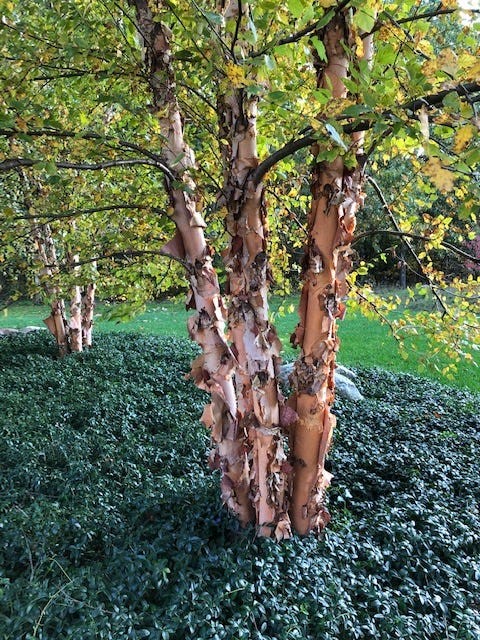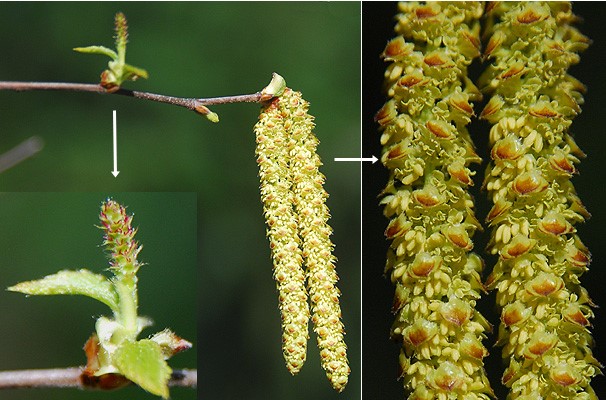Betula nigra: River Birch
Latin name: Betula nigra
Common name: Betula nigra
Flowers: The flower inflorescence on this tree is catkin, with gold/yellow or light green flowers, that can be 1-3 inches in size, that are showy and bloom in the spring 13
Fruit: This tree produces an aggregate/nut type of fruit, that ranges from gold to yellow and is displayed in the spring/summer 13
Height & Width: This tree can be 30-50’ wide and up to 90’ high 10, 13
Type: Deciduous 13
Habit: Multi-trunked, open, and pyramidal growth habit 13
Wetland indicator category**: FACW 17
Texture: Medium 13
Growth rate: Rapid 13
Light: Full sun to partial shade 13, 10
Moisture: Moist 10
Soil*: Prefers slightly acidic soils, and thrives in sandy, moist soils, sand, sandy loam, medium loam, clay loam, clay, acid-based soil 13, 10
Zones: 4 to 9 12
Origin: Eastern US 16
Ecosystem benefits: Food and habitat for wildlife, attracts pollinators 10, 13


Features: This tree is very desirable, with the exfoliating bark that really shows in the winter after the golden/yellow leaves fall off. Has a very open, multi-trunked, pyramidal growth pattern 13. The seeds from the fruit and cones help to attract birds and other wildlife 10.
Siting: This tree can be sited in an array of different places, from a home lawn to a winter garden, rain garden, and even a pollinator garden. These trees are usually planted in mass groupings and sometimes as a specimen. As long as the plant gets full to partial sun, moist, and slightly acidic soils it will thrive 13, 10.
Care: Plant so root flare is visible at soil surface 14. At planting, water the root ball daily with two gallons of water per inch of trunk diameter for two weeks, every other day for two months and then weekly until established. Modify water recommendations to reflect site drainage and rainfall. Apply 3” of mulch over the planted area. Do not allow mulch to touch the trunk 14.
Pests: Plants are relatively pest resistant if cultural preferences are met 7.
This plant does not appear on the following invasive plant lists on 2/15/22:
USDA SC Invasive Plant Species
SC Exotic Plant Pest Council
Author: Lauren Skyler Murray
Image source:
A) https://www.google.com/url?sa=i&url=https%3A%2F%2Fwww.dispatch.com%2Fstory%2Flifestyle%2F2020%2F12%2F20%2Fnative-plant-river-birch-colorful-tree-showy-bark%2F6512917002%2F&psig=AOvVaw1hBO_KyPX3yuaHt-IRh2Ej&ust=1645020487911000&source=images&cd=vfe&ved=0CAsQjRxqFwoTCKC75oPxgfYCFQAAAAAdAAAAABAE
B) https://landscapeplants.oregonstate.edu/sites/plantid7/files/plantimage/benih789.jpg
Sources:
- Armitage, A. (2001). Armitage’s manual of annuals, biennials, and half-hardy perennials. Portland, OR: Timber Press.
- Armitage, A. (2006). Armitage’s native plants for North American gardens. Portland, Oregon: Timber Press.
- Armitage, A. (2008). Herbaceous perennial plants: A treatise on their identification, culture, and garden attributes. Athens, GA: University of Georgia.
- Clemson Cooperative Extension Home and Garden Information Center.(2011). Flowers fact sheets. Retrieved from http://www.clemson.edu/extension/hgic/plants/landscape/ flowers/
- Clemson Cooperative Extension Home and Garden Information Center.(2011). Groundcovers & vines fact sheets. Retrieved from http://www.clemson.edu/ extension/hgic/plants/landscape/groundcovers/
- Clemson Cooperative Extension Home and Garden Information Center.(2011). Trees. Retrieved from http://www.clemson.edu/extension/hgic/ plants/landscape/trees/
- Clemson Cooperative Extension Home and Garden Information Center.(2011). Shrubs. Retrieved from http://www.clemson.edu/extension/hgic/plants/landscape/shrubs/
- Dirr, M. A. (2009). Manual of woody landscape plants. Champaign, IL: Stipes Publishing.
- Gilman, E. F. (1997). Trees for urban and suburban landscapes. Albany, NY: Delmar Publishers.
- Lady Bird Johnson Wildflower Center University of Texas at Austin. (2012). Native plant information network. Retrieved from http://www.wildflower.org/explore/
- McMillan, P., Plant taxonomist Clemson University, personal communication.
- Missouri Botanical Garden Kemper Center for Home Gardening. Plant finder. Retrieved from http://www.mobot.org/gardeninghelp/plantfinder/Alpha.asp
- North Carolina State University (2005). Plant fact sheets. Retrieved from http://www.ces.ncsu.edu/depts/hort/consumer/factsheets/index.html
- Strother, E. V., Ham, D. L., Gilland, L. (2003) Urban tree species guide: Choosing the right tree for the right place. Columbia, SC: South Carolina Forestry Commission.
- University of Florida, IFAS Extension. (2011). Southern trees fact sheet. Retrieved from http://edis.ifas.ufl.edu/department_envhort-trees
- USDA . Plant profile. (n/d).Retrieved from http://plants.usda.gov/java/
- USDA. Plant wetland indicator status. (n/d). Retrieved from http://plants.usda.gov/wetland.html
- Vincent, E., Environmental horticulturist Clemson University, personal communication.
- Clemson Extension. Carolina Yards Plant Database. Retrieved from https://www.clemson.edu/extension/carolinayards/plant-database/index.htm
*Soil pH is determined using a professional soil test. Contact your Clemson University County Extension service for assistance www.clemson.edu/extension/. Click on “local offices”.
**2012 Plant Wetland Indicator categories (quantitative derived) http://plants.usda.gov/wetinfo.html
| Indicator Code | Indicator Status | Comment |
|---|---|---|
| OBL | Obligate Wetland | Almost always is a hydrophyte, rarely in uplands |
| FACW | Facultative Wetland | Usually is a hydrophyte but occasionally found in uplands |
| FAC | Facultative | Commonly occurs as either a hydrophyte or non-hydrophyte |
| FACU | Facultative Upland | Occasionally is a hydrophyte but usually occurs in uplands |
| UPL | Obligate Upland | Rarely is a hydrophyte, almost always in uplands |
